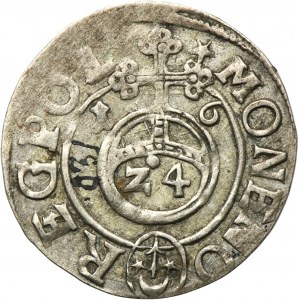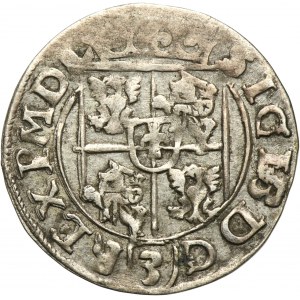Rare variety with the Sas coat of arms in a circle on the reverse, the beginning of the obverse legend SIGI and the ending MDL, the reverse legend begins and ends with asterisks.
The background of the monetary history of the Commonwealth during the reign of Sigismund Vasa was the progressing monetary crisis caused by the situation in Germany and the influx of degraded German coins to Poland. Initially, the mint rate was determined by the ordinance of Stefan Batory from 1580. In a situation of deepening crisis, in 1601 a decision was made to raise the mint rate, i.e. to devalue the denominations in circulation. In the following years, further legal acts appeared that reduced the content of silver in particular denominations. Of these, the ordinance of 1623 was the most important. It introduced a stable monetary system based on the monetary system of the empire. During the reign of Sigismund III, new denominations appeared in the Polish-Lithuanian Commonwealth: Trzykrucierzówki, Półkarucierzówki, and Orty. In turn, in 1621, the highest denomination in the history of Polish money was minted in the Bydgoszcz Mint - the Stud-Katówka. It was the culmination of the intensive issue of gold coins during the reign of Sigismund III. During this period, there were royal mints (Olkusz, Wschowa, Poznań, Malbork, Bydgoszcz, Lublin, Kraków, Warsaw), Lithuanian (Vilnius), municipal (Gdańsk, Elbląg, Toruń, Ryga, Poznań, Wschowa) and a private mint in Łobżenica. Sigismund Vasa's Swedish coins were issued by mints in Stockholm, Rewal and Malbork. In 1627, a decision was made to suspend the issue of small coins. This decision remained in force until 1650.
The issue of half-barrels began in 1614 for the needs of trade with Brandenburg, and then with Silesia. The drawing of the reverse with the characteristic apple resembled German pennies (apfelgroschen). The denomination was on the coin in two places. The number "24" placed in the apple meant that a half-barrel was 1/24 of a thaler (in fact, its value was lower). In turn, the number "3" at the bottom of the obverse meant that the coin was worth 3 half groszy. Crown half-toraks were minted in the Bydgoszcz mint and in another mint (varieties with crossed hooks). The literature mentions the Wschowa and Kraków mints, or possibly the second production line of the Bydgoszcz mint. Lithuanian half-toraks were issued by the Vilnius mint, while city mints were issued by Riga. During the reign of Sigismund III, half-half coins were minted on the basis of three minting regulations: 1614 (mark VII ½ lut; pure silver content - 0.739 g), 1619 (VI ½ lut; 0.5 g), 1623 (VI ½ lut; 0.45 g).









